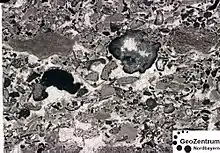Rudstone
The Dunham classification (Dunham, 1962[1]) did not consider grain size as a criterion for the description of carbonate lithologies. In an attempt to rectify this perceived deficiency, Embry & Klovan (1971[2]) introduced the terms rudstone (grain supported) and floatstone (matrix supported) for coarse-grained allochthonous carbonates. Following a survey of the use of the Dunham classification, Lokier and Al Junaibi (2016)[3] clarified the definition of a rudstone as "a carbonate-dominated rock where more than 10% of the volume is comprised of grains larger than 2 mm and these grains support the fabric of the rock."
Rudstone is a type of carbonate rock.

Rudstone with micrite. Width of picture is 36mm

Rudstone with sparite. Width of picture is 36mm
References
- Dunham, R.J. (1962) Classification of carbonate rocks according to depositional texture. In: Classification of Carbonate Rocks (Ed. W.E. Ham), Am. Assoc. Pet. Geol. Mem., 1, 108–121.
- Embry, A.F. and Klovan, J.E. (1971) A Late Devonian reef tract on Northeastern Banks Island, NWT. Bull. Can. Pet. Geol., 19, 730–781.
- Lokier, Stephen W.; Al Junaibi, Mariam (2016-12-01). "The petrographic description of carbonate facies: are we all speaking the same language?". Sedimentology. 63 (7): 1843–1885. doi:10.1111/sed.12293. ISSN 1365-3091.
This article is issued from Wikipedia. The text is licensed under Creative Commons - Attribution - Sharealike. Additional terms may apply for the media files.